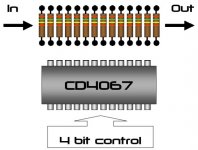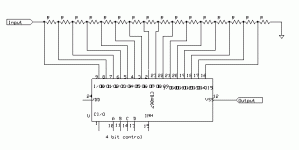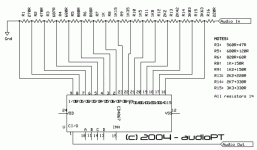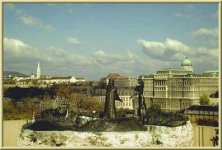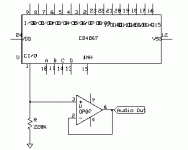Hi!
I'm wondering if anyone can help me with resistor values for this volume attenuator.
I'll command it with 4 bit to have 16 levels.
So, having the fisrt 10 levels with small difference, say 1 dB and the others from 3 dB, how can I figure out the resistors values?
Any formula?? Or I must use the ohm's law?
Thanks in advance
Pedro Martins
I'm wondering if anyone can help me with resistor values for this volume attenuator.
I'll command it with 4 bit to have 16 levels.
So, having the fisrt 10 levels with small difference, say 1 dB and the others from 3 dB, how can I figure out the resistors values?
Any formula?? Or I must use the ohm's law?
Thanks in advance
Pedro Martins
Attachments
till said:as a suggestion, take a look at the d1-svr-man.pdf at passlabs.
i can´t find any english pages at your www.
I'm updating the layout, sorry...
When I'm finished, I'll send a mail to you
Member
Joined 2002
Guys,
I'm going to use the attenuator with 6 4067 to control a 5.1 preamp using one control unit.
This is only because I've got a log of PGA2310 and some PIC's but I still can't learn how to program them

Do you think it is a good second solution?
I'm going to use the attenuator with 6 4067 to control a 5.1 preamp using one control unit.
This is only because I've got a log of PGA2310 and some PIC's but I still can't learn how to program them


Do you think it is a good second solution?
This is only because I've got a log of PGA2310 and some PIC's but I still can't learn how to program them
If you don´t need them - send them to me.
You can simply use my code to controll the PGAs. At the moment i make a version for 16F877, for 16F628 you find here: http://home.tu-clausthal.de/~tpa/PGA/03.asm
I made some volume controll with 4067, even 256steps, with two units🙂
It works well, but for low distortion use very high input impedance buffer for it. I used two opamps (one between the two 4067) with gain of 1, non inverting, with 330-470kohm resistor between the +input and the gnd. Some muting is also necessary to avoid switch noises....
sajti
It works well, but for low distortion use very high input impedance buffer for it. I used two opamps (one between the two 4067) with gain of 1, non inverting, with 330-470kohm resistor between the +input and the gnd. Some muting is also necessary to avoid switch noises....
sajti
Hi Sajti,
Any schematics of the buffer? And the midlle one?
I'm working in a full schematic on my PC to share with the Diyaudio Community.
Be patient because the design is on paper and I'm working hard today in my office because of tomorrow's holiday and the weekend...
I'm going to try put here the prototype of the pcb's also.
Any schematics of the buffer? And the midlle one?
I'm working in a full schematic on my PC to share with the Diyaudio Community.
Be patient because the design is on paper and I'm working hard today in my office because of tomorrow's holiday and the weekend...
I'm going to try put here the prototype of the pcb's also.
The buffer was simple unity gain opamp. (Output connected back to the - input) My friend try to make valve buffer, with cathode follower connected E88CCs (looks crazy idea for me )
)
I think that any load above 100komh will be good, and there will be no distortion.
I have schematics only on paper, at home...
sajti
 )
)I think that any load above 100komh will be good, and there will be no distortion.
I have schematics only on paper, at home...
sajti
Thanks for the nice pictures 🙂 I see them every day🙂
So I think the buffers are not so difficult to make. And if You apply just one 4067/ch, and Your poweramp has high input impedance, You don't need any buffer to use.
sajti
So I think the buffers are not so difficult to make. And if You apply just one 4067/ch, and Your poweramp has high input impedance, You don't need any buffer to use.
sajti
- Status
- Not open for further replies.
- Home
- Amplifiers
- Solid State
- CD4067 Volume control
